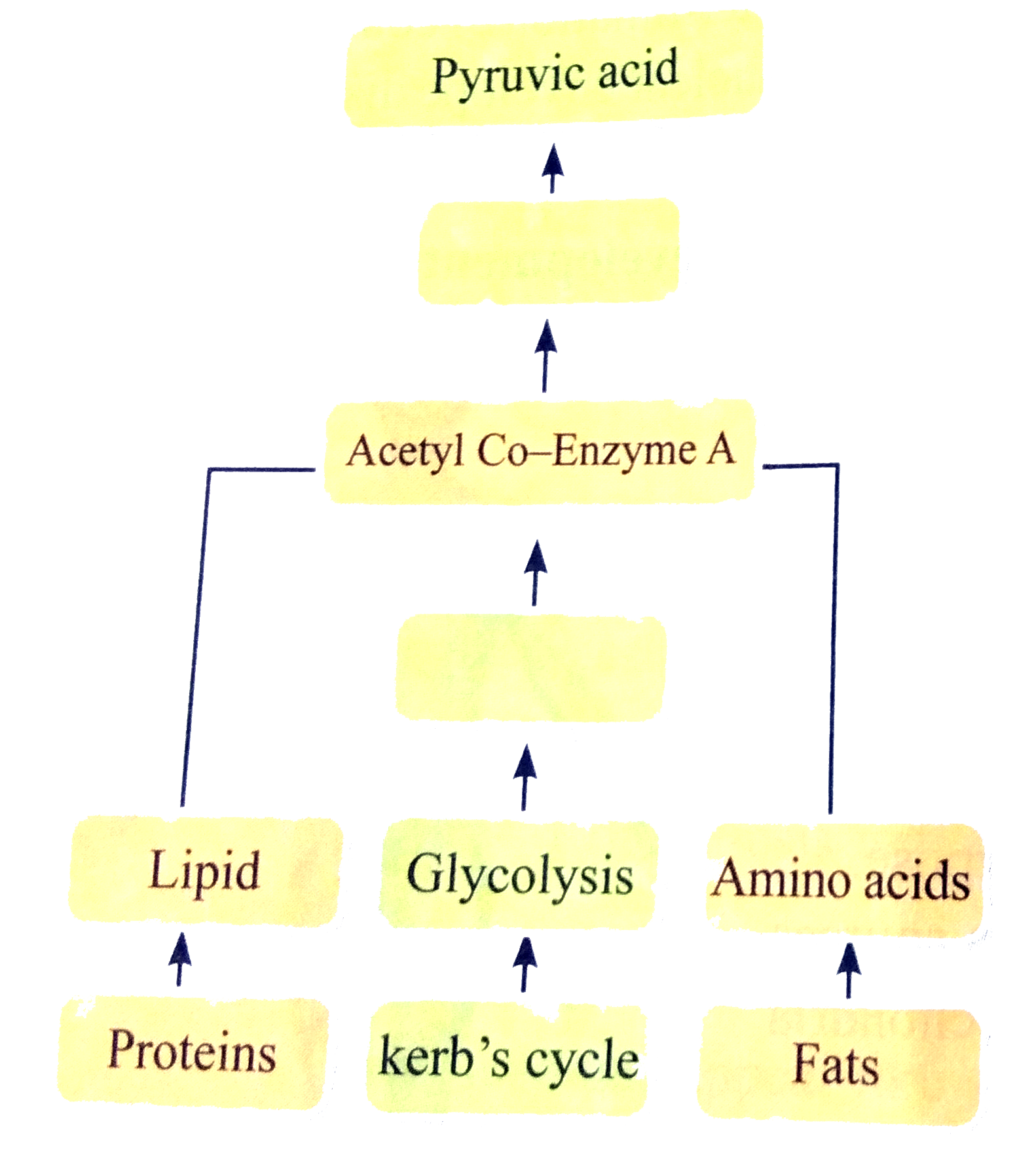How is energy formed from oxidation of carbohydrates, fats and proteins?
Text Solution
(1) First of all the dietary carbohydrates are digested in the digestive system with the help of various enzymes and converted into glucose. Similarly, proteins are converted into amino acids and fats are broken down into fatty aid and glycerol (alcohol).
(2) Oxidation of carbohydrates takes place during cellular respiration. Glucose is oxidized by three steps during aerobic respiration, viz. glycolysis, tricarboxylic acid cycle or Krebs cycle and electron transfer chain.
(3) From one molecule of glucose two molecules of each pyruvic acid ATP NADH and water are formed during glycolysis. Pyruvic acid ' ' 2 which is formed in this process is converted into Acetyl-Coenzyme-A along with release of two molecules each of NADH2 and CO2 .
(4) In the next step, i.e. in TCA cycle, molecules of Acetyl-Co-A enter the mitochondria and a cyclic chain of reactions take place. Acetyl part of Acetyl-Co-A is completely oxidized through this cyclical Process The molecules CO2,H2O,NADH2,FADH2 are released in this . 2' 2 ' 2' 2 process.
(5) In third step, i.e. in ETC reaction, NADH2 and FADH2 formed during first two steps are used for obtaining ATP molecules. 3 molecules of ATP are obtained from each NADH2 molecule and 2 molecules of ATP from each FADH2.
(6) Thus, one molecule of glucose upon complete oxidation in presence of oxygen yields 38 molecules of ATP. This is how from carbohydrates, energy is obtained.
(7) If carbohydrates are insufficient in diet, then proteins or lipids are used for energy production. Fatty acids derived from fats and amino acids derived from proteins are converted into Acetyl-Co-A. Acetyl-Co-A once again can yield energy through TCA cycle.
|
Topper's Solved these Questions
- ANSWER THE QUESTIONSBook:NAVNEET PUBLICATION - MAHARASHTRA BOARDChapter:ANSWER THE QUESTIONSExercise:Life Processes in Living Organisms : Part- 2
Explore 10 Videos
- ANSWER THE QUESTIONSBook:NAVNEET PUBLICATION - MAHARASHTRA BOARDChapter:ANSWER THE QUESTIONSExercise:Towards Green Energy
Explore 3 Videos
- ANSWER THE QUESTIONSBook:NAVNEET PUBLICATION - MAHARASHTRA BOARDChapter:ANSWER THE QUESTIONSExercise:Disaster Management
Explore 7 Videos
- ANIMAL CLASSIFICATION Book:NAVNEET PUBLICATION - MAHARASHTRA BOARDChapter:ANIMAL CLASSIFICATION Exercise:Project - based MCQs:
Explore 4 Videos
- BOARD ACTIVITY SHEET:MARCH 2019Book:NAVNEET PUBLICATION - MAHARASHTRA BOARDChapter:BOARD ACTIVITY SHEET:MARCH 2019Exercise:Answer any one of the following question (4)
Explore 3 Videos
Similar Questions
Knowledge Check
The common source of carbohydrates, fats and proteins is
AriceBmilkCeggDgheeThe common source of carbohydrates, fats and proteins is
AriceBmilkCeggDgheeThe two forms of vitamin B2 which are the co-enzymes required for carbohydrate, fats and protein metabolism are
ANAD+ and NADP+BFAD and NADP+CFMN and FADDFMN and NAD
Give a schematic pathway of TCA cycle as common pathway for oxidation of carbohydrates, fats and proteins.
View SolutionWhat is the physiologic fuel value of carbohydrate, fat, and proteins?
View SolutionWhat is respiratory quotient ? Give RQ for carbohydrates fats and proteins
View SolutionDefine respiratory quotient. Give the RQ for carbohydrates, fats and proteins.
View SolutionThe ______ is the site of complete digestion of carbohydrates, proteins and fats in the human body.
View Solution


